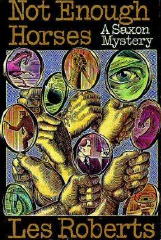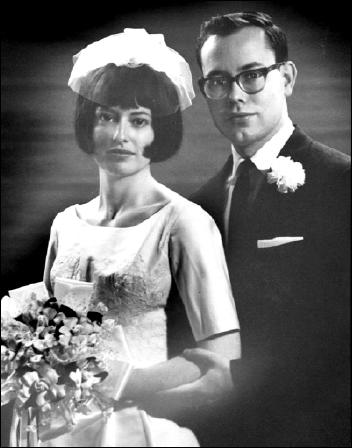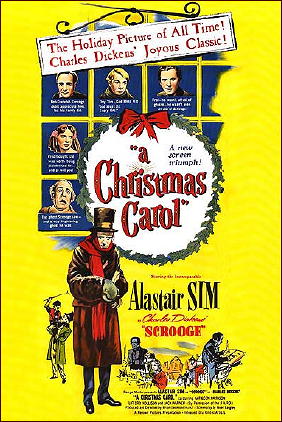December 2009
Monthly Archive
Thu 31 Dec 2009
THE BACKWARD REVIEWER
William F. Deeck
H. F. M. PRESCOTT – Dead and Not Buried. Dodd Mead; US, hardcover, 1938. Constable, UK, hc, 1938. Hardcover reprint: Eyre & Spottiswoode, UK, 1957 (shown). Paperback reprint: Collier Books, US, 1965.
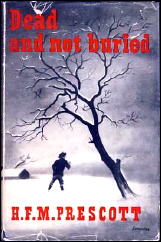
There is no introduction to Old Marshall, the corpse. At the very beginning he has been brutally murdered. The man who did it is unknown to the reader, at least for a while. The woman who watches the murder being committed and who later shields the murderer is Marshall’s wife.
Old Marshall’s corpse disappears, so the police, in the form of Sergeant Tucker, a wise and thoughtful man no longer eager for success, don’t know what has happened to Marshall. Did he just leave the farm or was there foul play?
On a nearby chicken farm live Mark (sometimes Marc) Yorke, moneyed, elegant, and a tad snobbish, and Philipson (first name unknown, which seems to happen frequently in mysteries, at least the ones I read), a shell-shocked sometime artist who is also Quite clumsy, which saves his life on at least two occasions.
Despite the lack of a body, Philipson is suspected of having done away with Marshall. Unfortunately for Philipson, he is suffering from temporary amnesia about what happened the afternoon of Marshall’s death.
The foregoing is a bare description that really does not do justice to this novel. The reader knows who did it fairly early on — a man who has murdered one person and has twice tried to kill another one, but who dog-ears a page in a book “with compunction.”
Prescott has sketched her characters amazingly well, with attention to the small things that bring people alive. Most of them, particularly the vicar, the. vicar’s daughter, Sergeant Tucker, and Mrs. Harker, who cooks for Yorke and Philipson, are people you will enjoy having met.
Prescott wrote no other mystery novels, which is a great pity. Her talent was considerable. For those who like their mystery novels catalogued, I would put this in the English-village and Holy Terror categories.
– From The MYSTERY FANcier, Vol. 9, No. 5, Sept-Oct 1987.
Bio-Bibliographic Data: As Bill pointed out, this was Ms. Prescott’s only work of crime fiction. Here’s some biographical data about her, taken from the Revised Crime Fiction IV, by Allen J. Hubin:
PRESCOTT, H(ilda) F(rances) M(argaret). 1896-1972. Educated at Oxford and Manchester; lived in Oxford.
There is considerably more about her to be found on the Internet, however. From her wikipedia page, for example:
“H F M Prescott is best known however for her historical novel The Man on a Donkey. Written in the form of a chronicle, the book tells the story of the Pilgrimage of Grace, a popular rising in protest at the Dissolution of the Monasteries by Henry VIII. Her biography of Mary I of England, Mary Tudor (originally titled Spanish Tudor), which won the James Tait Black Prize in 1941 remains one of the leading works on Mary I’s troubled life and reign and is named by the Encyclopaedia Britannica as the best biography of the monarch.”
Thu 31 Dec 2009
Posted by Steve under
Magazines[10] Comments
Taken in December of either 1902 or 1903…
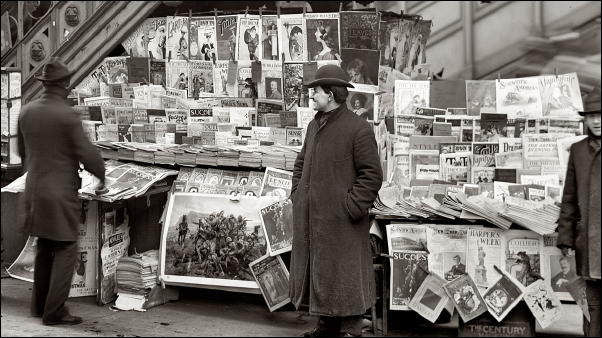
For an image with considerably more detail, one in which you can actually read the titles, go to:
http://www.shorpy.com/node/7392?size=_original
UPDATE. [01-01-10] The Internet is wonderful. The copy of Scientific American along the top right edge of the extended newsstand is dated 13 December 1902. See below:
Thu 31 Dec 2009
LES ROBERTS – An Infinite Number of Monkeys. St. Martin’s Press, hardcover, 1987. Paperback reprint: St. Martin’s, 1988.
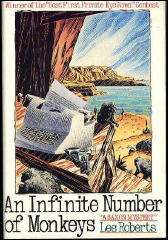
This is the novel that won Roberts the award in St. Martin’s “First Private Eye Novel Contest” back in 1986, and by and large, it’s a good one.
The leading character is a part-time actor named Saxon, who is also a full-time PI, which is more than OK as a gimmick, because Hollywood is always in need of another private eye. Lots of good stories in them there hills.
His client in this particular adventure is pulp-paperback writer Buck Weldon, a throwback to the Mickey Spillane’s earliest days, and somebody is trying to kill him. Keeping Saxon’s interest at its highest peak is Weldon’s beautiful daughter Tori. (For some reason, I pictured a youthful Raquel Welch in the role, which you have to admit, makes for a very nice picture.)
I have to admit the ending surprised me a little, and it shouldn’t have, which is the sign of a perfect detective story, or very nearly so. Saxon needs to have some of his cruder edges sandpapered away, though. As a ladies’ man, he’s too obvious, and besides that, he talks too much. Be subtle, man!
– This review first appeared in
Deadly Pleasures, Vol. 1, No. 2, Summer 1993 (slightly revised).
Bibliographic Data: Monkeys was Les Roberts’ first book, and there were six in all that Saxon appeared in (see below). Roberts has written another 14 books about Cleveland-based PI Milan Jacovich, so far, the most recent of which being King of the Holly Hop (2008). One stand-alone novel (The Chinese Fire Drill, 2001) plus one short story collection (The Scent of Spiced Oranges, 2002) complete his resume to date.
The “Saxon” series:
1. An Infinite Number Of Monkeys (1987)
2. Not Enough Horses (1988)
3. A Carrot For The Donkey (1989)
4. Snake Oil (1990)
5. Seeing The Elephant (1992)
6. The Lemon Chicken Jones (1994)
Wed 30 Dec 2009
Judy and I, 45 years ago. We were married in Jamaica. New York City, that is. Queens.
Tue 29 Dec 2009
REVIEWED BY DAN STUMPF:
● MURRAY LEINSTER – The Monster from Earth’s End. Gold Medal s832, paperback original; 1st printing, January 1959.
● THE NAVY VS. THE NIGHT MONSTERS. Realart Pictures, 1966. Mamie Van Doren, Anthony Eisley, Billy Gray, Bobby Van, Pamela Mason. Director: Michael A. Hoey.
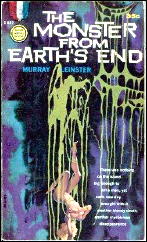
Interestingly, a couple decades after “Who Goes There?” John W. Campbell’s story which was the basis for The Thing from Another World (reviewed here ), Murray Leinster visited that neck of the woods for The Monster from Earth’s End, which is a splendid book despite a cover that looks like a naked blonde in the clutches of a giant booger.
It’s set on a remote Antarctic island serving as a way station for people and things going to and from the South Pole, and Leinster starts off splendidly, with the creepy arrival on the island of a plane carrying a mysterious cargo; most of the crew has vanished, and the pilot kills himself on landing.
From here on the tension never lets up, as Leinster takes up the mood Campbell established in his tale and sustains it for nearly two hundred pages of solid chills. I particularly like the way he draws his characters as individuals — like those in the Howard Hawks film — and lets them carry as much of the story as the monsters do. And trust me, these are some very creepy monsters indeed.
The Monster from Earth’s End was filmed (rare for a paperback original) as The Navy vs. the Night Monsters in 1966 by Michael Hoey, son of the fondly-remembered Dennis Hoey and a busy movie-maker in his own right, though never a very distinguished one: he worked on a few Elvis Presley movies and a lot of Television and that’s about it. Navy may mark some notable point in his career, high or low, depending on your tolerance for schlock.
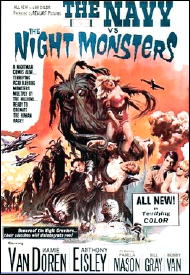
As such, it’s … well … let’s be charitable and say it’s not completely successful. There’s some lurid photography by Stanley Cortez (Night of the Hunter), some of the characters are a bit deeper than usual, and there was obviously an attempt to re-capture the ambiance of Hawk’s The Thing, with spots of banter and sexual repartee among the principals (Mamie Van Doren, Anthony Eisley, Bobby Van…)
Unfortunately, it all falls terribly flat in Hoey’s oven-mitts. Where The Thing benefited from Hawks’ overlapping dialogue and relaxed mise-en-scene, the characters in Navy/Monsters look like they were stood up in front of a camera handed their lines and that’s it. The comedy relief is very clearly labeled: “Comedy Relief” with posed pratfalls; love scenes are marked: “Love Scene” with syrupy underscoring, and the scary bits…
…well, there’s another problem. Where Leinster could toss off a line like “Half the plane now was filled with monstrous, moving, incredible horrors,” and let the reader’s imagination do his work, and where Hawks tingled our spines with brief glimpses of some big nasty-looking Thing, Hoey has to trot out a few silly-looking rubber monsters and let them flop their limp tentacles about rather aimlessly while the actors try to look scared.
It’s all a bit disappointing, and the resolution comes off as particularly lame, as if at some point they decided to just end the damn thing. Too bad they didn’t do it 90 minutes sooner.
Mon 28 Dec 2009
Posted by Steve under
Reviews[3] Comments
REVIEWED BY WALTER ALBERT:
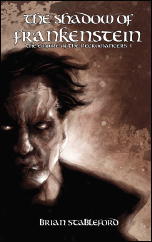
BRIAN STABLEFORD – The Shadow of Frankenstein: The Empire of the Necromancers #1. Black Coat Press; trade paperback, 2008.
Stableford, who has translated a number of French nineteenth-century thrillers, begins a saga conceived of as a sequel to Paul Féval’s John Devil, originally published in France in 1861 but recently translated by Stableford and published by Black Coat Press in 2005.
In his introduction to Shadow of Frankenstein Stableford describes John Devil as “a long and complicated duel of wits” between John Devil, a legendary figure whose identity is something of a mystery, and Gregory Temple, an English detective.
Temple’s career has been damaged by John Devil, but in the sequel Temple is back on the job, in pursuit of his arch-enemy, reluctantly accepting the help of Ned Knob, a secondary character in Féval’s novel who, in the continuation, assumes a major role, demonstrating both intelligence and some moral fibre as he seeks to find his place between the rational world of Temple and the messianic vision of John Devil.
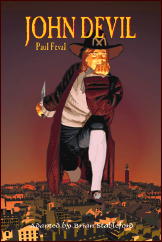
Stableford merges the Frankenstein mythos and the very real traffic in dead bodies that was a major source for cadavers used in medical research to create a vision of a world in which a means of achieving physical resurrection after death has been achieved.
Stableford has pared the thriller of much of its exterior Gothic trappings, but kept the concept of warring intelligences, reason combating an almost religious belief in a new science that threatens established systems.
While I found Stableford’s ideas of more than passing interest, I found the novel something of a chore to read. There’s a coolness to the prose, possibly the result of an attempt to avoid some of the excesses of the thriller form.
Much of the novel is concerned with the laying out of the framework of a novelistic grand plan, and it’s possible that succeeding volumes may recapture some of the impulsive thrust that can still engage a modern reader in the conventions of 19th century genre fiction.
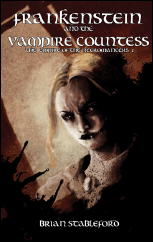
I rather suspect, however, that Stableford has failed at some basic level to write a novel that compels me to return to this series to discover if it takes on a life of its own.
Editorial Comment: Number two in this series by Stableford has now been published: Frankenstein and the Vampire Countess (Black Coat Press, 2009). Contents: “The Return of Frankenstein” and “The Vampire in Paris,” which appeared respectively in Tales of the Shadowmen Nos. 4 and 5.
Sun 27 Dec 2009
Reviewed by DAVID L. VINEYARD:
ARSÈNE LUPIN. 2004. Raymond Duris, Kristin Scott Thomas, Pascal Greggory.
Director: Jean-Paul Salomé, Screenplay: Jean-Paul Salomé and Laurent Vachaud, based on the novel La comtesse de Cagliostro (aka The Memoirs of Arsène Lupin) by Maurice Leblanc. In French with subtitles; 131 minutes.
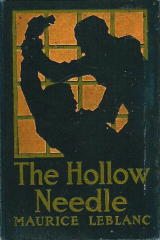
“Louis XI. François 1st. Henri IV. Louis XIV. Arsène Lupin.
“What pride I felt the day I set foot in this forgotten place.
“To have found the lost secret of the Kings of France, to become its master, its only master, to receive such inheritance!”
— Arsène Lupin in
L’Aiguille Creuse (
The Hollow Needle), Chapter 10, by Maurice Leblanc.
For those who only know the name Arsène Lupin, a brief introduction is in order. Lupin is a French gentleman burglar/detective created by journalist Maurice Leblanc (1864-1941) in the feuilletons or newspaper serials that dominated French popular fiction from the days of Alexandre Dumas and Eugene Sue well into the 20th Century.
Lupin debuted in the magazine Le Sais Tout in 1905, and the stories were collected in 1907’s Arsène Lupin, Gentleman Burglar (aka Arsène Lupin in Prison and Arsène Lupin Escapes), following the pattern established by Ponson du Terraill’s picaresque Rocambole two generations earlier.
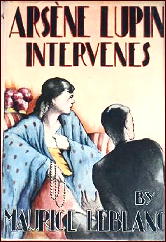
Twenty volumes followed with The Billions of Arsène Lupin being the last to be published in Leblanc’s lifetime in 1941. Unlike many of his fellow laborers in the disposable newspaper serials, Lupin carved a place for himself as the premier example of the French detective story, his international fans extending to President Theodore Roosevelt and beyond.
A genius with a keen sense of justice, panache, and an ego to match, Lupin is one of the most fully imagined characters in the genre, and the star of countless films, books, comics, and even animated adventures. Three American films, many French films and television series, Japanese films and anime, even a Philippine television series have all followed.
Lupin is a master of disguise and has a small army of identities under which he operates including private detective Jim Barnett, Prince Sernine, Don Luis Perena, M. Lenormand (who rises to no less than the head of the Surete), and others. As often as not Lupin may not be identified as Lupin until late in the tale — if at all.
Like most fictional criminals, he changes midway in his career to more detective than thief rivaling Sherlock Holmes with whom he had two memorable encounters (today the books use Holmes’ name, but at the time he was Herlock Sholmès), but even at his most criminal he is a righter of wrongs and defender of the weak, and like Holmes he is given to a sort of manic depression, very high highs and low lows (several times he considers suicide when all is lost).
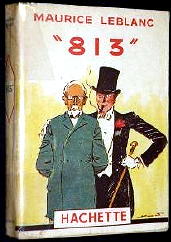
If Lupin is a younger brother to Raffles, he is at least that or more to the Saint. That said, Lupin is a very Gallic hero, given to dramatic flair and boasting. Compared to Lupin, Poirot, the Belgian, is a shrinking violet.
Over his long career he also acquires a great deal of wealth, numerous wives and lovers, a lost son, and even his own submarine (The Secret of Sarek) given to him for his services to a Moroccan prince (his adventures, both recorded and only referred to carry him to the literal ends of the Earth — to Antarctica, Saigon, Tibet, New York, Morocco … but always back to France).
In 813, the greatest of the Lupin sagas, he only just misses becoming a power in Europe by putting a puppet king on a European throne. He is possibly the most ambitious hero in the genre.
Today the adventures of his non-canonical grandson Lupin III, created by manga artist Monkey Punch and hero of anime and live action films (including The Castle of Cagliostro directed by anime legend Hayao Miyazaki) are better known to most than Lupin himself, but the original still has his charms, and in 2004 he returned to the big screen in a widescreen adventure worthy of a career that began in 1905 and which continues today.
In the 1950’s and 60’s five pastiche of his adventures were penned by Pierre Boileau and Thomas Narjeac, authors of Les diaboliques and Vertigo. Today many of the books are still in print, and his adventures continue in pastiche form in the Black Coat Press “Tales of the Shadowmen” anthologies.
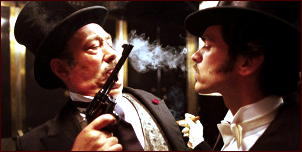
Arsène Lupin, the film, is based on Leblanc’s 1924 novel Le comtesse de Cagliostro (in the US and UK, The Memoirs of Arsène Lupin), which recounts the origins of Lupin and his first great adventure.
Taking a cue from that, the film opens with Lupin’s childhood where he is the son of a young woman virtually indentured to her well-married half sister and a teacher of fencing and martial arts (particularly savate — French kick boxing).
The young Lupin is enamored of his cousin, and unaware of the tensions in the house — or that his father is a thief after a fabulous necklace owned by his uncle — in fact the necklace — the infamous piece of jewelry owned by Marie Antoinette that helped to spur the French Revolution and part of the lost jewels of the kings of France.
When the police come for Lupin’s father, he escapes, but returns and enlists Arsène to steal the necklace, but he is apparently killed in a struggle with an accomplice within sight of the famous “Needle” a peculiar shaped rock off the French coast, and Arsène and his mother are exiled from their home, young Arsène swearing revenge on society and particularly on his uncle and men like him.
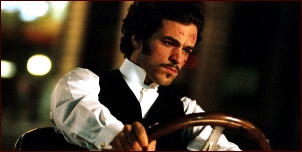
Some years later we meet the youthful adult Arsène (Raymond Duris) on board a gala yacht for a costume ball. Despite his grand manner, monocle, and white tie and tails he is little more than a pickpocket, but a talented one.
It’s at this point he meets the beautiful Countess Cagliostro, Josephine Balsamo (Scott Thomas), who claims to be the granddaughter of Joseph Balsamo. the notorious Count Cagliostro, charlatan, con man, and according to some, alchemist and wizard. (See Dan Stumpf’s review of the film Black Magic and his review of the Alexandre Dumas pere novel Joseph Balsamo elsewhere on this blog.) She takes young Arsène under her wing as her lover and student and transforms him from a mere pickpocket into a master criminal.
But there are dark undercurrents stirring. There is a mysterious cabal of wealthy men sworn to protect the secrets of the lost jewels of the French kings, plus the dangerous man who serves them and is the sworn enemy of Josephine, — the strange scarred man who serves Josephine and distrusts Arsène, and Josephine herself — who rumor has it is not the grand daughter of Cagliostro, but the daughter — the immortal daughter over a century old.
Eventually Lupin breaks with her, but by now he too is sworn to uncover the secrets of the lost treasure of the king’s of France which leads him back to the cousin he once loved as a youth.
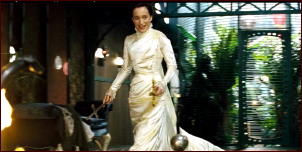
Thus begins the duel of wits between Lupin and the Countess and the cabal who protect the lost treasure. Cross and double-cross, buckled swashes, gallant gestures, disguise, and the elegance of France in another age are on display in a handsome film that manages to keep tongue in cheek in true Lupin style while never laughing at itself or the audience for enjoying it.
Though the plot is complex and elements from several of the Lupin novels are brought in, the plot is easy to follow, and Duris makes a charming Lupin, one who grows from something of a talented ruffian in gentleman’s clothing to a master criminal and suave adventurer.
He has a gamin quality, a rougher edge beneath the suave exterior that gives the character more depth than simply another charming adventurer — much like the original by Leblanc. Thomas as Josephine is simply lovely and clearly having fun playing the wicked and treacherous Josephine, and Eva Green as Lupin’s true love is both touching and beautiful in what could have been a throwaway role.
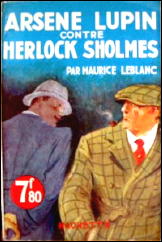
I’ll go no farther in describing the plot because I can’t without giving away too much, but needless to say, there are surprises to be had, and twists unexpected, before the film reaches its end, leaving you satisfied and wanting more.
But that said, and for any treasure hunters out there, despite the film and Leblanc’s book, the famous Needle which features in the film and the Lupin novel, The Hollow Needle, is not hollow, but solid rock. The lost treasures of the French kings will have to be found somewhere else.
Arsène Lupin is a beautifully shot film that seems to have that same slightly golden glow of photographs of that gilded age. It’s not only a handsome film to look at, but one of the most lavish and playful any genre film has earned. It is also faithful to both the letter and spirit of the Leblanc novels. It’s more than worthy of Lupin and his adventures.
And a word has to be said for the cinematography of Pasal Ridao. The film is a delight to look at with stunning camera work and sets and costumes adding real depth to the proceedings.
Lupin was played by John Barrymore in Arsène Lupin (1932, with Lionel cast as his nemesis Inspector Ganimard and Karen Morley in a racy pre-code role as an undercover police agent helping to trap Lupin — it’s delightfully ripe old time cinema) and Melvyn Douglas in Arsène Lupin Returns.
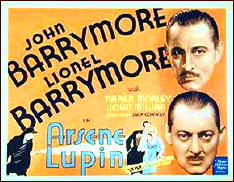
Charles Korvin played the role in a later film. In France, Robert Lamoureaux, George Descrieres, Jean-Claude Brialy, and Jean-Pierre Cassel have all played Lupin in several films and television series (available in boxed sets, but in French).
There have also been Lupin comics in France, an animated series, and there were several radio series, one hosted by Lupin himself. In Japan Lupin was played by a Japanese actor in live action films and later featured in an anime aside from the popular Lupin III films and series. In the Philippines a series about a wealthy playboy who was really a thief was called Lupin ran and is also available on DVD.
Lupin has also appeared in Jean-Marc and Randy Lofficier’s “Tales of the Shadowmen” anthology series from Black Coat Press, most recently in my own “The Jade Buddha” in volume 5 of that series in which he encounters the real model for Fu Manchu, Hanoi Shan.
There are several good French sites for Lupin, and you can learn a good deal more about him at the sites for Black Coat Press and the French Wold-Newton Universe including full bibliographies, chronologies, and filmographies.
Many of the Lupin books are in print, and those that are not relatively easy to find for the most part, and quite a few are available to read online or download as free ebooks including Leblanc’s two science fiction novels and a few of the non-Lupin novels.
But even if you don’t want to dip into his literary adventures, treat yourself to this lavish and enjoyable film. Few creations in the genre have received so faithful or so lush a tribute.
Fri 25 Dec 2009
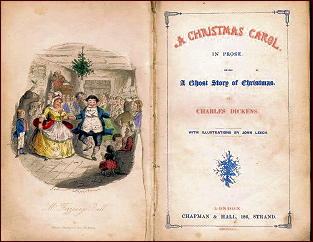
“A merry Christmas, Bob,” said Scrooge, with an earnestness that could not be mistaken, as he clapped him on the back. “A merrier Christmas, Bob, my good fellow, than I have given you for many a year. I’ll raise your salary, and endeavour to assist your struggling family, and we will discuss your affairs this very afternoon, over a Christmas bowl of smoking bishop, Bob. Make up the fires, and buy another coal-scuttle before you dot another i, Bob Cratchit.”
Scrooge was better than his word. He did it all, and infinitely more; and to Tiny Tim, who did not die, he was a second father. He became as good a friend, as good a master, and as good a man, as the good old city knew, or any other good old city, town, or borough, in the good old world. Some people laughed to see the alteration in him, but he let them laugh, and little heeded them; for he was wise enough to know that nothing ever happened on this globe, for good, at which some people did not have their fill of laughter in the outset; and knowing that such as these would be blind anyway, he thought it quite as well that they should wrinkle up their eyes in grins, as have the malady in less attractive forms. His own heart laughed: and that was quite enough for him.
He had no further interviews with Spirits, but lived upon the Total Abstinence Principle, ever afterwards; and it was always said of him, that he knew how to keep Christmas well, if any man alive possessed the knowledge. May that be truly said of us, and all of us! And so, as Tiny Tim observed, God bless Us, Every One!
— A Christmas Carol, by Charles Dickens.
Wed 23 Dec 2009
This list of Christmas mysteries, compiled by Caryn Wesner-Early, first appeared in Mystery*File 40, December 2003, and being all of six years old, is surely long out of date by now. Don’t that dissuade you from finding one or more of these to read over the next twelve days or so!
Adamson, Lydia. A Cat in the Manger
Adamson, Lydia. A Cat in the Wings
Adamson, Lydia. Cat on Jingle Bell Rock
Adamson, Lydia. A Cat Under the Mistletoe
Adrian, Jack. Crime at Christmas: A Seasonal Box of Murderous Delights
Alexander, David. Shoot a Sitting Duck
Allen, Garrison et al. Murder Most Merry
Allen, Michael. Spence and the Holiday Murders
Atherton, Nancy. Aunt Dimity’s Christmas
Babson, Marion. The Twelve Deaths of Christmas
Baker, Nikki. Long Goodbye
Barron, Stephanie. Jane and the Wandering Eye
Beaton, M.C. A Highland Christmas
Bernhardt, William. The Midnight Before Christmas
Black, Gavin. A Dragon for Christmas
Blades, Joe and Jeffrey Marks, eds. A Canine Christmas
Blake, Nicholas. The Corpse in the Snowman
Borthwick, J.S. Dude on Arrival
Boylan, Eleanor. Pushing Murder
Braun, Lillian Jackson. The Cat Who Turned On and Off
Braun, Lillian Jackson. The Cat Who Went Into the Closet
Brett, Simon. Christmas Crimes at Puzzle Manor
Cameron, Eleanor. The Mysterious Christmas Shell (children’s)
Cavanna. Betty. The Ghost of Ballyhooly (children’s)
Christian, Mary Blount. Sebastian (Super Sleuth) and the Santa Claus Caper (children’s)
Christie, Agatha. Hercule Poirot’s Christmas (Murder for Christmas, A Holiday for Murder)
Churchill, Jill. A Farewell to Yarns
Churchill, Jill. The Merchant of Menace
Clark, Carol Higgins. Iced
Clark, Mary Higgins. All Through the Night
Clark, Mary Higgins. Silent Night
Clark, Mary and Carol Higgins. Deck the Halls
Constantine, K.C. Upon Some Midnight Clear
Corcoran, Barbara. Mystery on Ice
Cornwell, Patricia. From Potter’s Field
Cornwell, Patricia. Scarpetta’s Winter Table
Cramer, Kathryn and David G. Hartwell (eds.) Christmas Ghosts
Crowleigh, Ann et al. Murder Under the Tree (anthology)
Daheim, Mary. The Alpine Christmas
Daheim, Mary. Nutty As a Fruitcake
Dalby, Richard, ed. Crime for Christmas (anthology)
Dalby, Richard, ed. Mystery for Christmas (anthology)
D’Amato, Barbara. Hard Christmas
Davidson, Diane. Tough Cookie
Daws, Jeanne M. The Body in the Transept
Dawson, Janet. Nobody’s Child
Delaney, Joseph. The Christmas Tree Murders
Dobson, Joanne. Quieter Than Sleep
Douglas, Carole Nelson. Cat in a Golden Garland
Drummond, John Keith. ‘Tis the Season to Be Dying
Duffy, James. The Christmas Gang
Eberhart, Mignon G. Postmark Murder
Egan, Lesley. Crime for Christmas
Elkins, Aaron. A Deceptive Clarity
Emerson, Kathy Lynn. Face Down Upon an Herbal
Erskine, Margaret. House of the Enchantress
Faglia, Leonard and David Richards. 1 Ragged Ridge Road
Fairstein, Linda. The Deadhouse
Farrell, Kathleen. Mistletoe Malice
Ferrars, E.X. Smoke Without Fire
Ferris, Monica. A Stitch In Time
Fletcher, Jessica and Bain, Donald. A Little Yuletide Murder
Fletcher, Jessica and Bain, Donald. Murder She Wrote: Manhattans and Murder
Flynn, Brian. The Murders Near Mapleton
Foley, Rae. Where is Mary Bostwick?
Frazier, Margaret. The Servant’s Tale
Gano, John. Inspector Proby’s Christmas
Godfrey, Thomas, ed. Murder for Christmas (2 vols. – anthology)
Goodman, Jonathan, ed. The Christmas Murders (anthology)
Grafton, Sue. E Is for Evidence
Granger, Anne. A Season for Murder
Greeley, Andrew M. The Bishop and the Three Kings
Greenberg, Martin H., ed. Holmes for the Holidays
Greenberg, Martin H., ed. More Holmes for the Holidays
Greenberg, Martin H. and Carol-Lynn Rossel Waugh, eds. Santa Clues (anthology)
Grimes, Martha. The Man With a Load of Mischief
Gunn, Victor. Death on Shivering Sand
Haddam, Jane. Festival of Deaths (Hanukkah)
Haddam, Jane. Not a Creature Was Stirring
Haddam, Jane. A Stillness in Bethlehem
Hager, Jean. The Last Noel
Hall, Robert Lee. Benjamin Franklin and a Case of Christmas Murder
Hardwick, Richard. The Season to Be Deadly
Hare, Cecil. An English Murder
Harris, Charlaine. Shakespeare’s Christmas
Harris, Lee. The Christmas Night Murder
Hart, Carolyn. Sugarplum Dead
Hart, Ellen. Murder in the Air
Hay, M. Doriel. The Santa Klaus Murder
Heald, Tim, ed. A Classic Christmas Crime (anthology)
Healy, Jeremiah. Right to Die
Hemlin, Tim. A Catered Christmas
Hemlin, Tim. If Wishes Were Horses…
Hess, Joan. A Holly, Jolly Murder
Hess, Joan. O Little Town of Maggody
Heyer, Georgette. Envious Casca
Hirsh, M.E. Dreaming Back
Holland, Isabelle. A Fatal Advent
Holmes for the Holidays (anthology)
Hunter, Fred. Ransome for a Holiday
Hunter, Fred. ‘Tis the Season for Murder: Christmas Crimes
Iams, Jack. Do Not Murder Before Christmas
Innes, Michael. Christmas at Candleshoes
Jaffe, Jody. Chestnut Mare, Beware
Jahn, Michael. Murder on Fifth Avenue
Jordan, Cathleen. A Carol in the Dark
Jordan, Jennifer. Murder Under the Mistletoe
Kane, Henry. A Corpse for Christmas (Homicide at Yuletide)
Keene, Carolyn. A Crime for Christmas (children’s)
Kelner, Toni L.P. Mad As the Dickens
Kelly, Mary C. The Christmas Egg
Kitchin, C.H.B. Crime at Christmas
Koch, Edward I. and Wendy Corsi Staub. Murder on 34th Street
Langton, Jane. The Shortest Day
Lake, M.D. Grave Choices
Lambert, Elisabeth. The Sleeping House Party
Lewin, Michael Z. Family Planning
Lewis, Gogo and Seon Manley, eds. Christmas Ghosts (anthology)
Livingston, Nancy. Quiet Murder
McBain, Ed. And All Through the House
McBain, Ed. Downtown
McBain, Ed. Sadie When She Died
McClure, James. The Gooseberry Fool
McGown, Jill. Murder at the Old Vicarage
McKevett, G.A. Cooked Goose
MacLeod, Charlotte, ed. Christmas Stalkings (anthology)
MacLeod, Charlotte. Convivial Codfish
MacLeod, Charlotte, ed. Mistletoe Mysteries (anthology)
MacLeod, Charlotte. Rest You Merry
Mallowan, Agatha Christie. A Star Over Bethlehem and Other Stories
Manson, Cynthia, ed. Christmas Crimes (anthology)
Manson, Cynthia, ed. Murder Under the Mistletoe (anthology)
Manson, Cynthia, ed. Mystery for Christmas and Other Stories (anthology)
Markham, Marion M. The Christmas Present Mystery (children’s)
Maron, Margaret. Corpus Christmas
Marsh, Carole. Christmas Tree Mystery
Marsh, Ngaio. Tied Up in Tinsel
Meier, Leslie. Christmas Cookie Murder
Meier, Leslie. Mail Order Murder
Meier, Leslie. Mistletoe Murder
Meredith, D.R. Death By Sacrilege
Meredith, David William. The Christmas Card Murders
Meyers, Annette. These Bones Were Made for Dancin’
Miers, Earl. The Christmas Card Murders
Mortimer, John Clifford, ed. Murder at Christmas (anthology)
Moyes, Patricia. Who Killed Father Christmas? and Other Unseasonable Demises
Muller, Marcia. Both Ends of the Night
Muller, Marcia. There’s Nothing to Be Afraid Of
Murder Most Merry (anthology)
Murder Under the Tree (anthology)
Murray, Donna Huston. The Main Line is Murder
Nordan, Robert. Death Beneath the Christmas Tree
O’Marie, Sister Carol Anne. Advent of Dying
O’Marie, Sister Carol Anne. Murder in Ordinary Time
Page, Katherine Hall. Body in the Bouillon
Peters, Ellis. Monk’s Hood
Pulver, Mary Monica. Original Sin
Queen, Ellery. The Finishing Stroke
Raphael, Lev. Burning Down the House
Ray, Robert J. Merry Christmas Murdock
Resnick, Mike and Martin H. Greenberg, eds. Christmas Ghosts (anthology)
Robb, J.D. Holiday in Death
Roberts, Gillain. The Mummers’ Curse
Robinson, Peter. Past Reason Hated
Ruell, Patrick. Red Christmas
Sawyer, Corrine Holt. Ho-Ho Homicide
Serafin, David. Christmas Rising
Shannon, Dell. No Holiday for Murder
Sibley, Celestine. Spider in the Sink
Smith, Barbara Burnett. Mistletoe from Purple Sage
Smith, Barbara Burnett et al. ‘Tis the Season for Murder
Smith, Frank. Fatal Flaw
St. John, Wylly Folk. The Christmas Tree Mystery (children’s)
Trochek, Kathy Hogan. Midnight Clear
Waugh, Carol-Lynn Rossel, ed. The Twelve Crimes of Christmas (anthology)
Weir, Charlene. A Cold Christmas
Welk, Mary V. A Deadly Little Christmas
Williams, David. Murder in Advent
Windsor, Patricia. Christmas Killer
Windsor, Patricia. A Very Weird and Moogly Christmas
Wingfield, R.D. Frost at Christmas
Witting, Clifford. Catt Out of the Bag
Wolzien, Valerie. Deck the Halls with Murder
Wolzien, Valerie. ‘Tis the Season to Be Murdered
Wolzien, Valerie. We Wish You a Merry Murder
Woolley, Catherine. Libby’s Uninvited Guest
… And Checking It Twice:
In the letter column for Mystery*File 43, Jeff Meyerson added the following:
Agatha Christie, “The Adventure of the Christmas Pudding” (title novella in ss collection)
Agatha Christie, “Christmas Adventure” in While the Light Lasts (apparently the original, shorter version of the above).
Georges Simenon, “Maigret’s Christmas” (title story in ss collection)
Bill Crider, Terence Faherty, Wendi Lee, Aileen Schumacher, Murder, Mayhem and Mistletoe (paperback original; four Christmas-related stories)
[ Jeff goes on to say: ]
Caryn should also be aware of a very entertaining pamphlet published in 1982 by Albert Memendez called Mistletoe Malice: The Life and Times of the Christmas Murder Mystery (Silver Spring, MD, Holly Tree Press). The 35 pages goes through various Christmas mysteries and includes a checklist of 89 books, of which about 60 (at fast glance) are not on Caryn’s list. I think the majority of her list is post-1982 titles.
[ Later. ] These are the ones not listed on Caryn Wesner-Early’s list in M*F 40. Obviously, most of these are older books, while much of the list in M*F consists of books published since Mistletoe Malice was published in 1982.
Anthony Abbot, About the Murder of a Startled Lady
” ” About the Murder of Geraldine Foster
North Baker, Dead to the World
W. A. Ballinger, A Corpse For Christmas
Charity Blackstock, The Foggy, Foggy Dew
Nicholas Blake, Thou Shell of Death
” ” The Smiler With the Knife
Carter Brown, A Corpse for Christmas
Leo Bruce, Such is Death (Crack of Doom)
W. J. Burley, Death in Willow Pattern
Thomas Chastain, 911
Noel Clad, The Savage
Constance Cornish, Dead of Winter
Alisa Craig (Charlotte MacLeod), Murder Goes Mumming
Joel Dane, The Christmas Tree Murders
Frederick C. Davis, Drag the Dark
Mildred Davis, Tell Them What’s Her Name Called
” ” Three Minutes to Midnight
Spencer Dean, Credit for a Murder
Carter Dickson (John Dickson Carr), The White Priory Murders
“Diplomat”, The Corpse on the White House Lawn
Todd Downing, The Last Trumpet
Francis Duncan, Murder for Christmas
Mary Durham, Keeps Death His Court
Jefferson Farjeon, Mystery in White
Elizabeth X. Ferrars, The Small World of Murder
Ian Fleming, On Her Majesty’s Secret Service
Rae Foley, The Hundredth Door
Leslie Ford, The Simple Way of Poison
Roger Gouze, A Quiet Game of Bambu
Dulcie Gray, Dead Giveaway
Dashiell Hammett, The Thin Man
Lee Hays, Black Christmas
Edith Howie, Murder for Christmas
John Howlett, The Christmas Spy
Cledwyn Hughes, The Inn Closes For Christmas (He Dared Not Look Behind)
Fergus Hume, The Coin of Edward VII
Alan Hunter, Landed Gently
Michael Innes, A Comedy of Terrors (There Came Both Mist and Snow)
Glenn Kezer, The Queen is Dead
Kathleen Moore Knight, They’re Going to Kill Me
Alfred Lawrence, Columbo: A Christmas Killing
Ted Lewis, Jack Carter’s Law
Richard Lockridge, Dead Run
Miriam Lynch, Crime for Christmas
Ed McBain, The Pusher
” ” Ghosts
Helen McCloy, Two-Thirds of a Ghost
” ” Mr. Splitfoot
” ” Burn This
Anne Nash, Said With Flowers
Stuart Palmer, Omit Flowers
Jack Pearl, Victims
Ellery Queen, The Egyptian Cross Mystery
Patrick Quentin, The Follower
M. P. Rea, Death of an Angel
Jonathan Stagge, The Yellow Taxi
Elizabeth Atwood Taylor, The Cable Car Murder
Laurence Treat, Q as in Quicksand
Charles Marquis Warren, Deadhead
If your favorite seasonal mystery (or mysteries) is (are) not here, that’s what the comments box is for!
Mon 21 Dec 2009
Posted by Steve under
Reviews[11] Comments
Three More by EDWARD D. HOCH -The Christmas Edition
by Mike Tooney:
For Part Three of this series, go here.
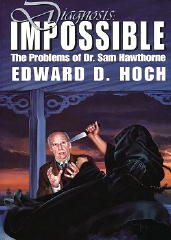
10. “The Problem of the Christmas Steeple.” Ellery Queen’s Mystery Magazine, January 1977. Reprinted in Diagnosis: Impossible: The Problems of Dr. Sam Hawthorne , by Edward D. Hoch. Crippen & Landru, hardcover/trade paperback, 1996.
He seemed like a good man who led a simple life and looked for simple solutions — which is why so many people disliked him. New Englanders, contrary to some opinions, are not a simple folk.
Comments: It’s December 1925, and a minister has been murdered in the steeple of his own church, a place from which no one could escape unseen — and the only other person, a gypsy, who was there, swears he didn’t do it.
Even Sheriff Lens, not normally quick on the uptake, suspects there’s more to this than first meets the eye: “Some said he was runnin’ a giant con game, while others thought he was more interested in the parish wives. Whatever the truth, his background was mighty shady.”
All of this sets Dr. Sam Hawthorne to wondering: “How could you have a locked room that wasn’t even a room — that was in fact open on all four sides? And how could you have a mystery when the obvious murderer was found right there with the weapon and the body?”
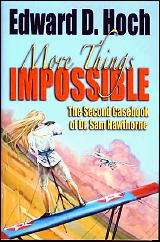
11. “The Problem of Santa’s Lighthouse.” Ellery Queen’s Mystery Magazine, December 1983. Reprinted in More Things Impossible: The Second Casebook of Dr. Sam Hawthorne, by Edward D. Hoch. Crippen & Landru, hardcover/trade paperback, 2006.
“We kept saying there were no suspects, but of course there was always one suspect. Not the least likely person but the most likely one.”
Comments: It’s Christmas 1931, but even a place celebrating peace on earth is not immune from violence. Visiting a lighthouse that has been converted to catch the seasonal trade, Dr. Sam Hawthorne witnesses — or almost witnesses — an impossible crime: “I looked up in in time to see a figure falling from the circular walkway at the top of the lighthouse …. Then I saw the handle of the dagger protruding from between his ribs and I knew that help was useless.”
But Dr. Sam never sees the perpetrator, even though it should have been possible. How can it be that someone on one end of a building could stab somebody else on the other end without being seen?
To complicate matters further, Sam runs afoul of a murderous gang anxious to protect a secret: “We made it halfway down the stairs before they caught us, and I tripped and stumbled the rest of the way to the ground floor, landing hard on my chest. I looked up and saw one of the men take out a knife ….”
If you remember your American history, you could surmise what that secret might be. (Hint: the 18th Amendment to the U. S. Constitution.)
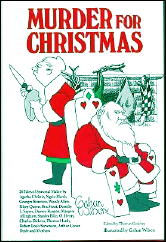
12. “Christmas Is for Cops.” Ellery Queen’s Mystery Magazine, December 1970. Reprinted in Murder for Christmas, edited by Thomas Godfrey. Mysterious Press, hardcover, 1982.
“Lock all the outside doors, Fletcher,” Leopold barked. “Don’t let anyone leave.”
“Is he dead, Captain?”
“As dead as he’ll ever be. What a mess!”
“You think one of our men did it?”
“Who else?”
Comments: It’s Christmas in Captain Leopold’s precinct, and a convivial party for all the policemen is in the offing.
It’s Leopold’s unhappy duty, however, to deal with one of his own men, a cop on the take. The evidence is incontrovertible, and the Captain is about to turn him over to the DA when the crooked cop begs him for more time. He admits his wrongdoing to Leopold but also claims he has an audio recording that will nail another cop in his unit who is also on the take. Reluctantly, the Captain grants the request.
The next evening, at the Christmas party, the fun is interrupted by the discovery of Leopold’s would-be informant, stabbed to death. The Captain is neck-deep in suspects now — over sixty cops plus their wives.
There’s also that unresolved matter of the recording. Leopold has reason to believe that, if it even exists, it’s either under or hidden somewhere on the big twenty-foot Christmas tree — but a careful search yields nothing.
And then there’s that piece of crime scene evidence that points the finger of guilt at the wife of his trustworthy subordinate, Lieutenant Fletcher.
Captain Leopold must untangle all these contradictions, or this Christmas won’t be merry at all.
Next Page »




